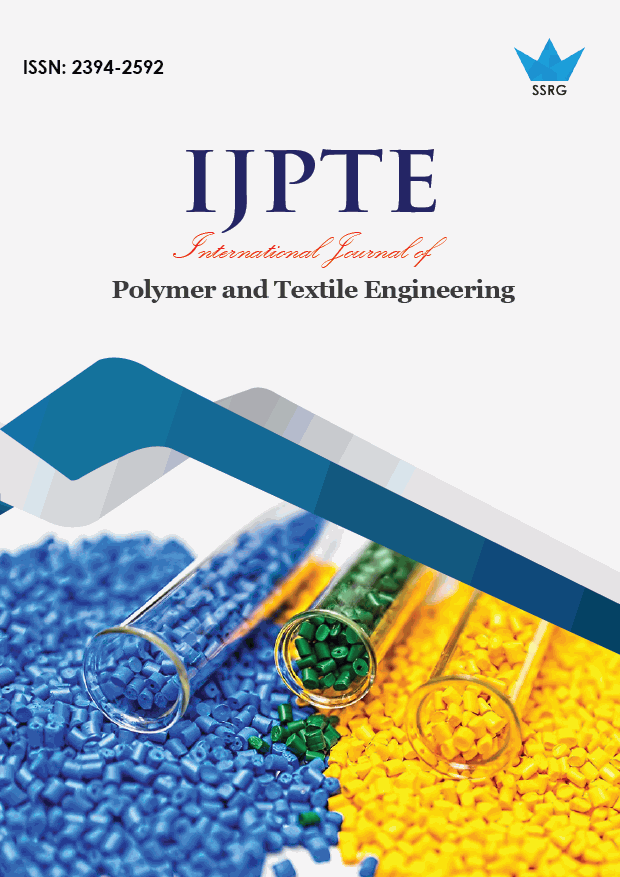Pre-post Bleaching Behaviors of Cotton Knits Using Reductive and Oxidative bleaches

| International Journal of Polymer and Textile Engineering |
| © 2020 by SSRG - IJPTE Journal |
| Volume 7 Issue 1 |
| Year of Publication : 2020 |
| Authors : Md Rashedul Alam, Md Rashedul Islam |
How to Cite?
Md Rashedul Alam, Md Rashedul Islam, "Pre-post Bleaching Behaviors of Cotton Knits Using Reductive and Oxidative bleaches," SSRG International Journal of Polymer and Textile Engineering, vol. 7, no. 1, pp. 42-53, 2020. Crossref, https://doi.org/10.14445/23942592/IJPTE-V7I1P106
Abstract:
Cotton fiber contains natural impurities on its’ surface. To remove those impurities, cotton is treated with several types of bleaching agents based on industrial practice. The study investigated pre-post behaviors of single jersey knit after the bleaching treatments. Two types of bleaching chemicals were used to perform the study: such as (a) reductive, and (b) oxidative bleaching agents. The specimens were subjected to weight loss, absorption, color measurement, and bursting strength tests at the pre-post stages of the bleaching. Results from the statistical analysis revealed that the bleaching treatments significantly impacted on the behaviors of cotton knits. The findings also disclosed that hydrogen peroxide bleaching in the alkaline medium had the superior bleaching performance in cotton fabrics.
Keywords:
Bleaching, Color Measurement, Dye Absorption, Bursting Strength
References:
[1] M. R. Islam, & U. Chowdhary, (2019). “Relative Color Pickup of Three Different Knits and Predictive Dyeing Recipe Formulation”. SSRG International Journal of Polymer and Textile Engineering 6(3), 1-16.
[2] A. D. Broadbent. “Basic Principles of Textile Coloration”. Society of Dyers and Colourists, 2001
[3] D. Yu, M. Wu, J. Lin, & J. Zhu, (2018). “Economical Low-Temperature Bleaching of Cotton Fabric Using an Activated Peroxide System Coupling Cupric Ions with Bicarbonate”. Fibers and Polymers, 19(9), 1898–1907. doi: 10.1007/s12221-018-7963-z
[4] A. Khatri, I. A. Sahito, F. Ahmed, & I. Khatri, (2017). “Fiber Quality Evaluation of Pakistan’s Locally Developed Cotton Varieties for Yarn Manufacturing”. Journal of Natural Fibers, 15(3), 344–352. doi: 10.1080/15440478.2017.1328328
[5] A. N. M. A. Haque, S. A. Smriti, N. Farzana, F. Siddiqa, & M. A. Islam, (2019). “Fuzzy Modelling for Prediction of Bursting Strength of Knitted Cotton Fabric using Bleaching Process Variables”. AATCC Journal of Research, 6(1), 29–37. doi: 10.14504/ajr.6.1.5
[6] M. Mr, H. F, L. X, Zakaria, & Q. H, (2016). “A Study on the Effects of Pre-treatment in Dyeing Properties of Cotton Fabric and Impact on the Environment”. Journal of Textile Science & Engineering, 06(05). doi: 10.4172/2165-8064.1000274
[7] M. Gunay, (2011). “The Future of Dye House Quality Control with the Introduction of Right-First Dyeing Technologies”. Textile Dyeing. doi: 10.5772/23091
[8] R. Alén, (2018). “Manufacturing Cellulosic Fibres for Making Paper: A Historical Perspective”. World Forests Technological Transformation in the Global Pulp and Paper Industry 1800–2018, 13–34. doi: 10.1007/978-3-319-94962-8_2
[9] U. Henniges, & A. Potthast, (2009). “Bleaching Revisited: Impact of Oxidative and Reductive Bleaching Treatments on Cellulose and Paper”. Restaurator, 30(4). doi: 10.1515/rest.017
[10] N. Elsayed, R. N. Shaker, & R. M. Kotb, (2017). “Advances in Chemistry and Chemical Engineering: Chapter- 17: Neoteric Approach to One-Step Bleaching and Antibacterial Finishing of Cotton Fabric”. Retrieved from http://research.asu.edu.eg/handle/123456789/167190
[11] J. Gacén, J. Cegarra, & M. Caro, (2008). “Wool bleaching with reducing agent in the presence of sodium lauryl sulphate”. Part 3-bleaching with thiourea dioxide. Journal of the Society of Dyers and Colourists, 107(4), 138–141. doi: 10.1111/j.1478-4408.1991.tb01320.x
[12] P. Malkavaara, J. P. Isoaho, R. AlN, & J. Soininen, (2000). “Dithionite bleaching of thermomechanical pulp: factors having effects on bleaching efficiency”. Journal of Chemometrics, 14(5-6), 693–698. doi: 10.1002/1099-128x(200009/12)14:5/6<693::aid-cem612>3.0.co;2-7 [13] L. Bramble, (2019). “Oxygen Bleach Vs. Chlorine Bleach”. Retrieved from https://sciencing.com/oxygen-bleach-vs-chlorine-bleach-6571838.html [14] M. I. Bahtiyari, & H. Benli, (2019). “Comparison of Ozone-Based Cold Bleaching Processes with Conventional Pretreatment of Cotton”. Ozone: Science & Engineering, 1–11. doi: 10.1080/01919512.2019.1704218 [15] A. Nazir, F. Arooj, & S.R. Kashif, (2017). “Comparison of Various Additives in Cotton Bleaching Efficiency”. Journal of Environmental Analytical Chemistry, 04(04). doi: 10.4172/2380-2391.1000218
[16] M. Fišerová, E. Opálená, J. Gigac, & M. Stankovská, (2018). Oxidative and Reductive Bleaching of Deinked Pulp. Retrieved from http://www.woodresearch.sk/wr/201804/10.pdf
[17] M. O. Bulut, (2016). “Low temperature bleaching for reactive dyeing and top white knitted cotton fabric”. Journal of Cleaner Production, 137, 461–474. doi: 10.1016/j.jclepro.2016.07.124
[18] E. Abdel-Halim, (2012). “An effective redox system for bleaching cotton cellulose. Carbohydrate Polymers”, 90(1), 316–321. doi: 10.1016/j.carbpol.2012.05.044
[19] H. H. Piccoli, A. A. U. D. Souza, & S. M. A. G. U. D. Souza, (2014). “Bleaching of Knitted Cotton Fabric Applying Ozone”. Ozone: Science & Engineering, 37(2), 170–177. doi: 10.1080/01919512.2014.939742
[20] P. Bajpai, (2012). “Hydrogen Peroxide Bleaching. Environmentally Benign Approaches for Pulp Bleaching”, 97–134. doi: 10.1016/b978-0-444-59421-1.00005-3
[21] Sodium hypochlorite. (2015). Reactions Weekly, 1550(1), 188–188. doi: 10.1007/s40278-015-0534-9
[22] J. Church, (1999). “Hypochlorite Bleach. Surfactant Science Handbook of Detergents”, Part A, 619–629. doi: 10.1201/b10985-17
[23] W. Smith, (2008). “Inorganic Bleaches. Surfactant Science Handbook of Detergents”, Part F, 435–472. doi: 10.1201/9781420014655.ch24
[24] L. A. Holt, & B. Milligan, (1980). “The Use of Thiourea Dioxide in the Reductive Bleaching and Fluorescent Whitening of Wool”. The Journal of The Textile Institute, 71(2), 117–119. doi: 10.1080/00405008008631535
[25] D. J. Spencer. Knitting Technology: “a Comprehensive Handbook and Practical Guide”. Cambridge: Woodhead Publ., 2001.
[26] ASTM D 2260-03 (2013), ASTM International, West Conshohocken, PA, USA, 2016, www.astm.org
[27] ASTM D 3776-02, ASTM International, West Conshohocken, PA, USA, 2016, www.astm.org.
[28] R. Kumar. “Evaluation of The Early Impacts of The Better Cotton Initiative on Smallholder Cotton Producers.” AEA Randomized Controlled Trials, 2016, doi:10.1257/rct.986-1.0.
[29] AATCC 79 (2018). AATCC technical manual. New York, N.Y: Published for the Association by Howes Pub. Co.
[30] J. Schwiegerling. “Colorimetry: CIELAB Color Space.” Field Guide to Visual and Ophthalmic Optics, doi:10.1117/3.592975.p71.
[31] Whiteness and Yellowness Indices in a SpectroEye. (n.d.). Retrieved from https://www.xrite.com/service-support/whiteness_and_yellowness_indices_in_a_spectroeye
[32] ASTM D 3786 (2018), ASTM International, West Conshohocken, PA, USA, 2016, www.astm.org
[33] U. Chowdhary, & M. R. Islam, (2019). Pre-Post Wash Wicking Behavior, Moisture Transfer, and Water Repellency of Plain, Twill and Satin Weaves. Journal of Textile Science & Fashion Technology, 2(3). doi: 10.33552/jtsft.2019.02.000539

 10.14445/23942592/IJPTE-V7I1P106
10.14445/23942592/IJPTE-V7I1P106